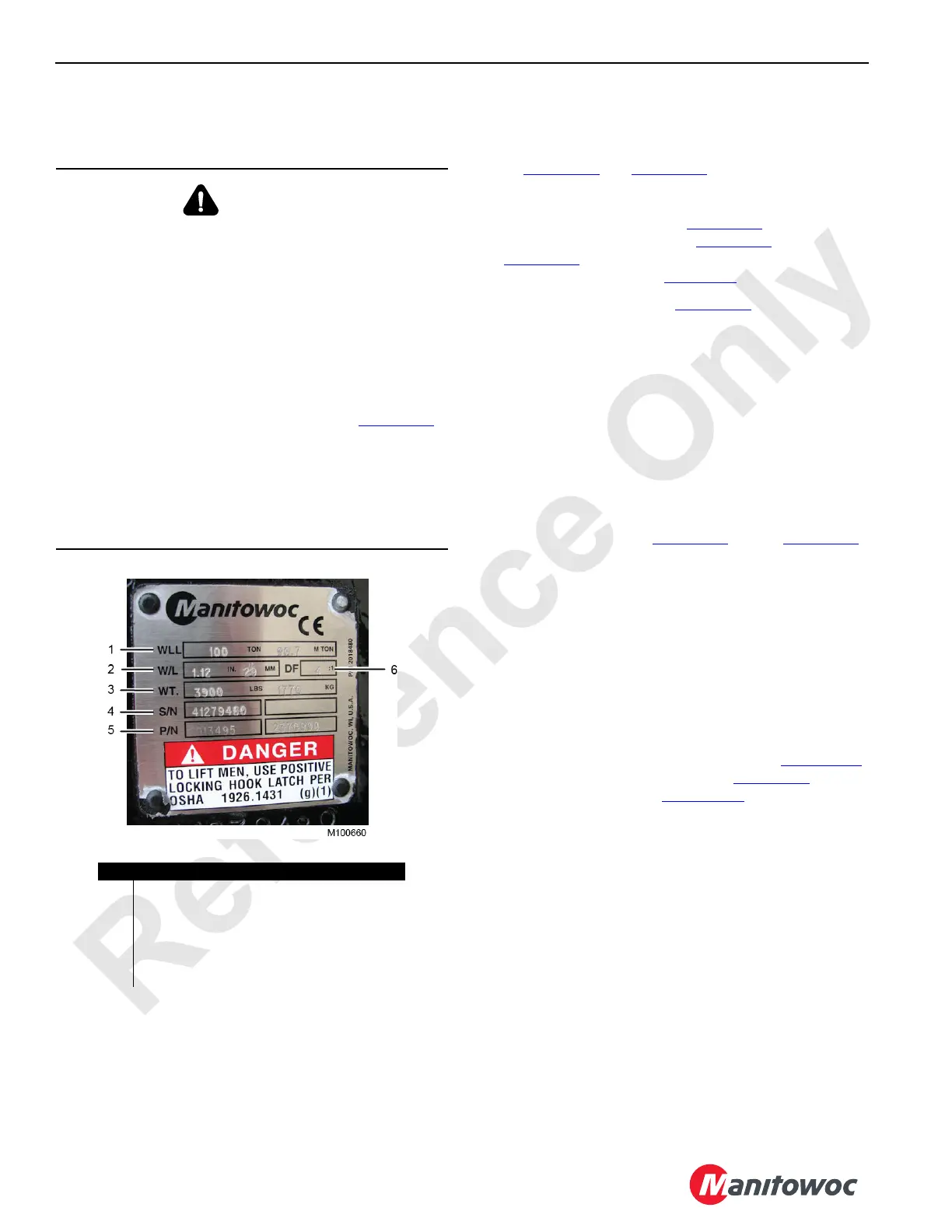HOISTS 2250 SERVICE/MAINTENANCE MANUAL
5-34
Published 07-19-16, Control # 249-01
INSPECTING THE LOAD BLOCK AND
HOOK-AND-WEIGHT BALL
The operating condition of the load block and the hook-and-
weight ball can change daily with use. Therefore, they must
be inspected daily (at the start of each shift) and observed
during operation for any defects that could affect their safe
operation. Correct all defects before using the load block or
the hook-and-weight ball.
Daily inspection and maintenance include the following
points (Figure 5-34
and Figure 5-35).
1. Clean the load block or the hook-and-weight ball.
2. Lubricate the sheaves (4, Figure 5-35
) (if fittings are
provided), trunnion (9, Figure 5-35
), swivel (4,
Figure 5-34
), and any other part with a grease fitting at
the intervals specified in Lubrication
Section 9.
3. Tighten loose tie-bolts (3, Figure 5-35
), capscrews, and
set screws.
4. Verify that all cotter keys are installed and opened.
5. Check the sheaves for uneven wear in the grooves and
on the flanges. Check for loose or wobbly sheaves.
These conditions indicate faulty bearings or bushings.
6. Check the fit of the wire rope in the groove of each
sheave. An oversized wire rope can crack the lip of the
sheave flange, causing rapid wear of the wire rope and
sheave. The groove must be larger than the wire rope
and must be free of rough edges and burrs.
7. Verify that the hook (8, Figure 5-34
and 12, Figure 5-35),
trunnion, and swivel rotate freely without excessive play.
Faulty operation indicates faulty bushings, faulty
bearings, or inadequate lubrication.
8. Check the swivel of the hook-and-weight ball for the
following conditions:
• Overloading—Spin the swivel by hand. If the motion
is rough or has a ratchet-like effect, the swivel
bearings are damaged.
• Side loading—The swivel turns freely in one spot
and locks up in another. This condition can also be
checked by looking at the gap (4c, Figure 5-34
)
between the swivel barrel (4b, Figure 5-34
) and the
swivel shank (4a, Figure 5-34
) (swivel must be
removed from the weight ball to check). If the gap is
wide on the side and closed on the other, damage is
present.
NOTE: The gap between the barrel and the shank is
normally 0.51 to 1.27 mm (0.020 to 0.050 in). If the
gap increases, swivel bearing failure is indicated.
9. Check the load block for signs of overloading such as
spread side plates, elongated holes, bent or elongated
tie-bolts, and cracks.
10. Check all welds for defects and cracks.
11. Check the wire rope for wear and broken wires at the
point the wire rope enters the dead-end socket. Check
the socket for cracks. Tighten the wire rope clips at the
dead end of the wire rope.
WARNING
Falling Load Hazard!
Structural failure of the load block or hook-and-weight ball
will allow the load to drop, which can result in death or
serious injury.
To prevent the load from dropping due to failure of the
load block or hook-and-weight ball, observe the following:
• Only use a load block or a hook-and-weight ball that
has a capacity equal to or greater than the load to be
handled.
• Do not remove or deface the nameplate (Figure 5-33
)
attached to the load blocks and hook-and-weight
balls.
• See Section 4 of the Operator Manual for the
recommended sling angles and capacity restrictions
when the load block has a duplex or quadruplex
hook.
FIGURE 5-33
Item Description
1 Working Load Limit (ton (US and metric))
2 Wire Rope Diameter (in and mm)
3 Block Weight (lb and kg)
4 Block Serial Number
5 Block Part Number (OEM and Manitowoc)
6 Design Factor
